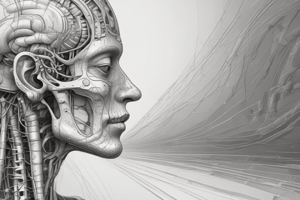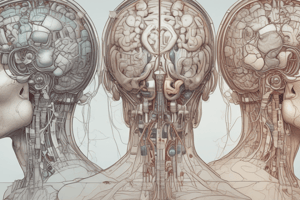Podcast
Questions and Answers
¿Cómo se caracteriza la distonía?
¿Cómo se caracteriza la distonía?
- Por temblores en las extremidades
- Por movimientos incontrolados de baile
- Por problemas de coordinación de movimientos
- Por contracciones musculares involuntarias y a menudo dolorosas (correct)
¿Cuál de las siguientes NO es una forma de tratamiento para la distonía?
¿Cuál de las siguientes NO es una forma de tratamiento para la distonía?
- Estimulación cerebral profunda
- Fisioterapia acuática (correct)
- Inyección de toxina botulínica
- Terapia física
¿Qué grupo de trastornos neurológicos está marcado por dificultades en la coordinación de movimientos, equilibrio, habla y movimientos oculares?
¿Qué grupo de trastornos neurológicos está marcado por dificultades en la coordinación de movimientos, equilibrio, habla y movimientos oculares?
- Cerebral palsy
- Dystonia
- Ataxia (correct)
- Huntington's disease
¿Cuál de las siguientes enfermedades afecta principalmente el balance, el habla y los movimientos oculares?
¿Cuál de las siguientes enfermedades afecta principalmente el balance, el habla y los movimientos oculares?
¿Qué enfermedad neurológica se caracteriza por movimientos involuntarios, alteraciones posturales, dificultades en la marcha y expresiones faciales alteradas?
¿Qué enfermedad neurológica se caracteriza por movimientos involuntarios, alteraciones posturales, dificultades en la marcha y expresiones faciales alteradas?
¿Cuál de las siguientes enfermedades tiene síntomas que se superponen con otros trastornos del movimiento?
¿Cuál de las siguientes enfermedades tiene síntomas que se superponen con otros trastornos del movimiento?
¿Cuál de las siguientes opciones describe mejor la enfermedad de Huntington?
¿Cuál de las siguientes opciones describe mejor la enfermedad de Huntington?
¿Qué enfoque terapéutico es comúnmente utilizado para el manejo de la enfermedad de Parkinson?
¿Qué enfoque terapéutico es comúnmente utilizado para el manejo de la enfermedad de Parkinson?
¿Cuál de las siguientes afirmaciones es verdadera sobre la parálisis cerebral?
¿Cuál de las siguientes afirmaciones es verdadera sobre la parálisis cerebral?
¿Cuál de las siguientes opciones es una característica clínica común de la enfermedad de Parkinson?
¿Cuál de las siguientes opciones es una característica clínica común de la enfermedad de Parkinson?
¿Cuál es uno de los enfoques terapéuticos para mejorar los síntomas motores en la enfermedad de Huntington?
¿Cuál es uno de los enfoques terapéuticos para mejorar los síntomas motores en la enfermedad de Huntington?
¿Qué tipo de trastorno es la ataxia según el texto proporcionado?
¿Qué tipo de trastorno es la ataxia según el texto proporcionado?
Flashcards are hidden until you start studying
Study Notes
Motor Disorders
Motor disorders are a diverse group of neurological conditions affecting various aspects of movement, including altered posture, gait, and facial expression. The four main subtypes of motor disorders are dystonia, ataxia, cerebral palsy, and huntington's disease. Additionally, we will discuss parkinson's disease because its symptoms overlap with those seen in other movement disorders. Each of these conditions presents unique challenges in terms of diagnosis, management, and prognosis.
Dystonia
Dystonia is characterized by involuntary and often painful muscle contractions leading to repetitive, prolonged movements or abnormal postures. It can occur in isolated or generalized forms and may affect various body regions, including the neck, arms, legs, trunk, or voice. Dystonic movements may fluctuate over time, be aggravated by stressful events, exhaustion, or specific emotional states, and peak during early evening hours. Physical therapy, botulinum toxin injection, or deep brain stimulation may reduce dystonic symptoms.
Ataxia
Ataxia is a broad category of neurological disorders marked by difficulties in coordinating movements, balance, speech, and eye movements. The condition can manifest as clumsiness, tremors, poor handwriting, or dysarthria. Ataxia can stem from various sources, such as metabolic disorders, neuromuscular diseases, inflammatory processes, autoimmune conditions, or environmental exposures. Currently, there are few effective therapies available for ataxia, other than supportive measures.
Cerebral Palsy
Cerebral palsy (CP) is a group of non-progressive motor disorders arising before age 18 months. CP results from injury to the developing brain, either before birth, around the time of birth, or shortly afterwards. Its clinical presentation is varied and includes hypertonia or hypotonía, exaggerated reflexes, involuntary movements, and impairments in balance, coordination, and fine motor skills. Multidisciplinary approaches, including physical therapy, occupational therapy, speech therapy, and orthopedic management, improve the overall outcome for individuals with CP.
Huntington's Disease
Huntington's disease is an autosomal dominant inherited disorder resulting from a triplet repeat expansion of the huntingtin gene. The disease leads to progressive motor dysfunction, accompanied by cognitive deficits and neuropsychiatric symptoms. Ultimately, Huntington's disease causes an irreversible loss of central nervous tissue. Somatic therapies aim to alleviate motor symptoms and psychological intervention may address cognitive and behavioral symptoms. There is currently no cure for Huntington's disease, but ongoing research continues to explore potential therapeutic strategies.
Parkinson's Disease
Parkinson's disease is a chronic and progressive movement disorder primarily attributed to dopamine depletion in the substantia nigra region of the brain. The condition is marked by tremor, rigidity, bradykinesia (slowness of movement), and postural instability. Parkinson's disease has no cure; treatments aim to manage symptoms through levodopa replacement therapy, dopamine agonists, monoamine oxidase-B inhibitors, or anticholinergic medications. Deep brain stimulation may provide additional benefits for patients with severe motor fluctuations.
In conclusion, each of these motor disorders presents unique challenges in terms of diagnosis, management, and prognosis. While there are currently no cures for these conditions, ongoing research continues to explore potential therapeutic strategies that can help alleviate symptoms and improve quality of life for those affected.
Studying That Suits You
Use AI to generate personalized quizzes and flashcards to suit your learning preferences.




